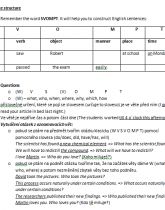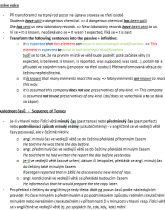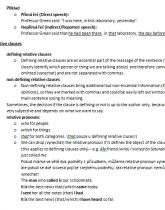Hledej
Zobraz:
Univerzity
Kategorie
Rozšířené vyhledávání
12 663
projektů
Gramatika - Anglický jazyk - jednoduché poznámky
| Přípona .docx |
Typ poznámky |
Stažené 2 x |
| Velikost 0,1 MB |
Jazyk český |
ID projektu 11719 |
| Poslední úprava 12.03.2018 |
Zobrazeno 1 665 x |
Autor: royal.cut |
 Sdílej na Facebooku
Sdílej na Facebooku |
||
| Detaily projektu | ||
- Cena:
6 Kreditů - kvalita:
90,5% -
Stáhni
- Přidej na srovnání
- Univerzita:Vysoká škola chemicko-technologická v Praze
- Fakulta:Fakulta potravinářské a biochemické technologie
- Kategorie:Jazyky » Angličtina
- Předmět:Anglický jazyk
- Studijní obor:-
- Ročník:1. ročník
- Formát:MS Office Word (.docx)
- Rozsah A4:12 stran
- Questions
o (W) V S (V) O M P T
o (W) - what, who, when, where, why, which, how
- příslovečné určení, které se pojí se slovesem (určuje to sloveso) je ve věte před ním (I quickly read your article in bed last night.)
- Ve větě je nejdříve čas a potom část dne (The students worked till 4 o´clock this afternoon)
- Vytváření otázek z oznamovacích vět:
o pokud se ptám na předmět tvořím otázku klasicky (W V S V O M P T) pomocí pomocného slovesa (do/does, did, have/has, will)
The scientist has found a new chemical element. => What has the scientist found?
We will have to redistill the compound. => What will we have to redistill?
I love Martin. => Who do you love? (Koho miluješ?)
o pokud se ptám na podnět otázku tvoříme tak, že na začátek věty dáme W (what, who, where) a potom nezměněný zbytek věty bez toho podnětu.
David took the pictures. Who took the pictures?
This process occurs naturally under certain conditions. => What occurs naturally under certain conditions?
The researchers published their new findings. => Who published their new findings?
Martin loves you. Who loves you? (Kdo tě miluje?)
o (W) V S (V) O M P T
o (W) - what, who, when, where, why, which, how
- příslovečné určení, které se pojí se slovesem (určuje to sloveso) je ve věte před ním (I quickly read your article in bed last night.)
- Ve větě je nejdříve čas a potom část dne (The students worked till 4 o´clock this afternoon)
- Vytváření otázek z oznamovacích vět:
o pokud se ptám na předmět tvořím otázku klasicky (W V S V O M P T) pomocí pomocného slovesa (do/does, did, have/has, will)
The scientist has found a new chemical element. => What has the scientist found?
We will have to redistill the compound. => What will we have to redistill?
I love Martin. => Who do you love? (Koho miluješ?)
o pokud se ptám na podnět otázku tvoříme tak, že na začátek věty dáme W (what, who, where) a potom nezměněný zbytek věty bez toho podnětu.
David took the pictures. Who took the pictures?
This process occurs naturally under certain conditions. => What occurs naturally under certain conditions?
The researchers published their new findings. => Who published their new findings?
Martin loves you. Who loves you? (Kdo tě miluje?)
Klíčová slova:
sentence structure
minulý čas
přítomný čas
předpřítomný čas
předminulý čas
předbudoucí čas
passive voice
Obsah:
- Sentence structure
Slovesné časy
Přítomný čas průběhový - Present Continuous
Předpřítomný čas prostý - Present Perfect Simple
Předpřítomný čas průběhový - Present Perfect Continuous
Minulý čas prostý - Past Simple
Minulý čas průběhový - Past Tense Continuous
Předminulý čas prostý - Past Perfect Simple
Předminulý čas průběhový - Past Perfect Continuous
Budoucí čas prostý - Future Tense Simple
Budoucí čas průběhový - Future Tense Continuous
Jiné způsoby vyjadřování budoucnosti :
Předbudoucí čas prostý a průběhový - Future Perfect Simple and Continuous
Passive voice
Souslednost časů - Sequence of Tenses
Nepřímá řeč a nepřímá otázka - Indirect speech and indirect question
Relative clauses
Common affixes
Verb patterns


